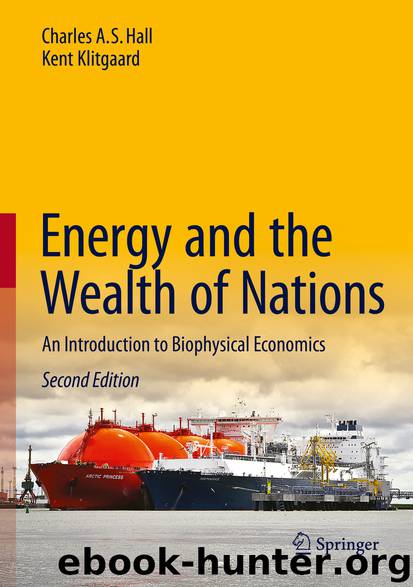Energy and the Wealth of Nations by Charles A. S. Hall & Kent Klitgaard

Author:Charles A. S. Hall & Kent Klitgaard
Language: eng
Format: epub
ISBN: 9783319662190
Publisher: Springer International Publishing
10.3.7 The End of the Liberal Growth Agenda
The liberal growth agenda was based on the idea that the government should stimulate economic growth but also had the power to “fine-tune” the economy to manage unemployment and inflation. This ideology and set of policies fell apart in the 1970s. The 1973 energy crisis was not the only force that crippled the US economy. In fact the pillars of postwar prosperity were all crumbling. The rising power of the oil-producing nations was only one sign of the end of Pax Americana. There were many others. Europe and Japan, once war-torn nations in a state of shock, caught up to, and even surpassed, the United States in terms of industrial output. The terms of trade, or the ratio of export prices to import prices, rose from near parity to 1.3 to 1 in 1972. They plummeted to less than 1.1 to one by 1979. Despite the rising cost, imports increased from 4% of GNP in 1948 to 10% in 1972. The US share of total world exports in 1955 was 32%. They stood at only 18% in 1972. The postwar monetary system was based on fiat money, where the value of a nation’s currency depends upon productive power and political stability. American productivity growth, which averaged 2.7% per annum in the 1950s, fell to 0.3% per year in the 1970s. As the rise in oil prices attests to, the United States no longer bought in a buyer’s market and sold in a seller’s market. Moreover, the expansion of cold-war military spending plus the outflow of funds directed toward direct foreign investment worsened the US balance of payment situation. The Bretton Woods Accords mandated the United States to convert holdings of foreign currencies to gold at the price of $35 per ounce. By 1973 outstanding claims exceeded the American gold stocks. Richard Nixon “closed the gold window,” and the Bretton Woods Accords collapsed, thereby ending the dominant position of the dollar and all its benefits. Soon, the world was to open up to an unprecedented increase in global oligopolistic rivalry. The days of the insulated oligopoly position of US business were nearing their end, and the demise was reflected in the decline of corporate profits. After-tax corporate profits for the nonfinancial sector, which averaged 10% in 1965, dropped to less than 3% in 1973.
With productivity growth on the decline and international dominance eroding, American corporations could no longer “afford” the expensive mechanisms of labor peace erected in support of the capital-labor accord. Less access to energy was a primary factor in the decline of productivity growth, and the capital-labor accord depended upon growing productivity. An “open shop movement” began in housing construction by the 1980s, and myriad consulting firms specializing in “managing without unions” also emerged. As a result, wages began to fall. Hourly income, which grew at 2.2% per year in the long expansion of 1948–1966, grew only at 1.5% year in the time period between 1966 and the 1973 oil boycott. Unemployment rates, which had been as low as 3.
Download
This site does not store any files on its server. We only index and link to content provided by other sites. Please contact the content providers to delete copyright contents if any and email us, we'll remove relevant links or contents immediately.
| Fluid Dynamics | Thermodynamics |
The Complete Stick Figure Physics Tutorials by Allen Sarah(6630)
Secrets of Antigravity Propulsion: Tesla, UFOs, and Classified Aerospace Technology by Ph.D. Paul A. Laviolette(3429)
Thing Explainer by Randall Munroe(3317)
The River of Consciousness by Oliver Sacks(2988)
The Order of Time by Carlo Rovelli(2708)
I Live in the Future & Here's How It Works by Nick Bilton(2519)
A Brief History of Time by Stephen Hawking(2470)
How To by Randall Munroe(2464)
The Great Unknown by Marcus du Sautoy(2178)
What If?: Serious Scientific Answers to Absurd Hypothetical Questions by Randall Munroe(2165)
Blockchain: Ultimate Step By Step Guide To Understanding Blockchain Technology, Bitcoin Creation, and the future of Money (Novice to Expert) by Keizer Söze(2134)
Midnight in Chernobyl by Adam Higginbotham(2075)
Networks: An Introduction by Newman Mark(1994)
The Meaning of it All by Richard Feynman(1905)
Easy Electronics by Charles Platt(1859)
The Tao of Physics by Fritjof Capra(1841)
When by Daniel H Pink(1771)
Midnight in Chernobyl: The Untold Story of the World's Greatest Nuclear Disaster by Adam Higginbotham(1770)
Introducing Relativity by Bruce Bassett(1750)
